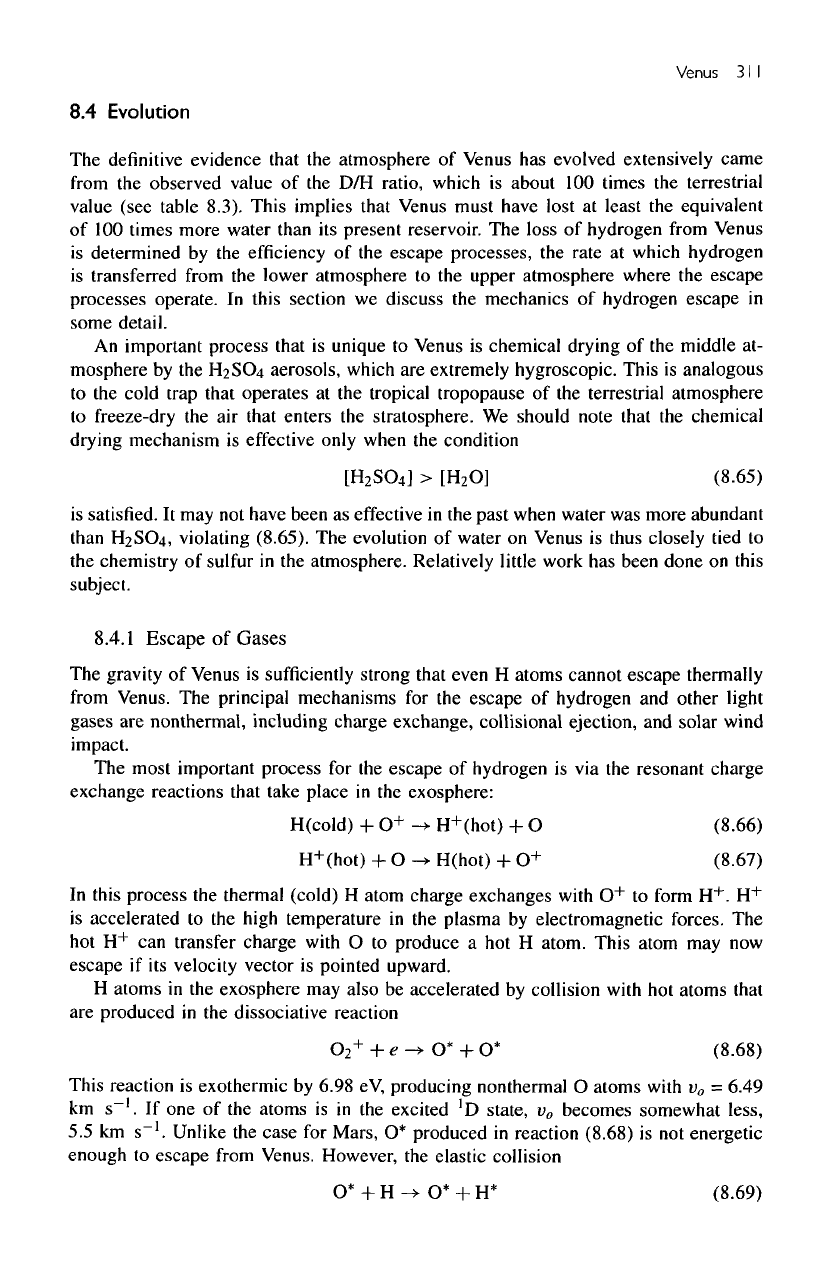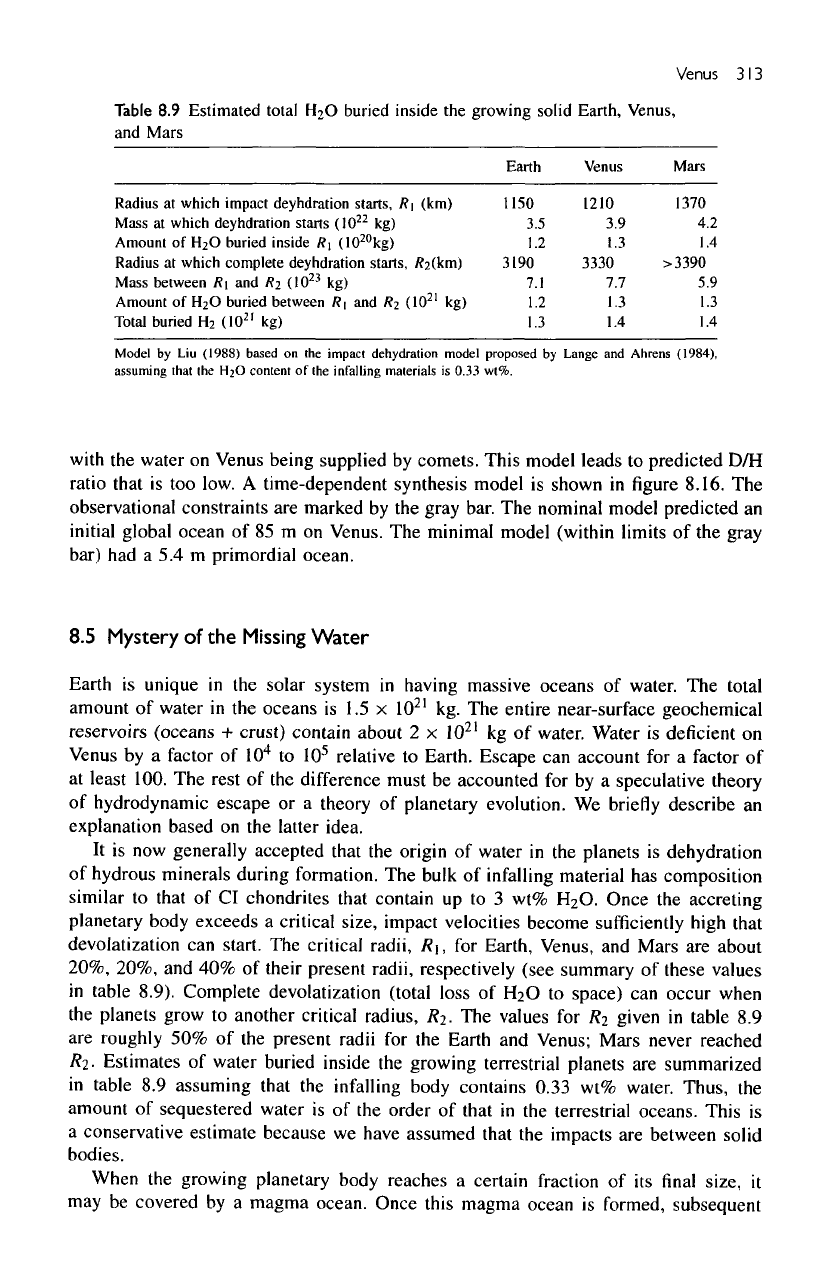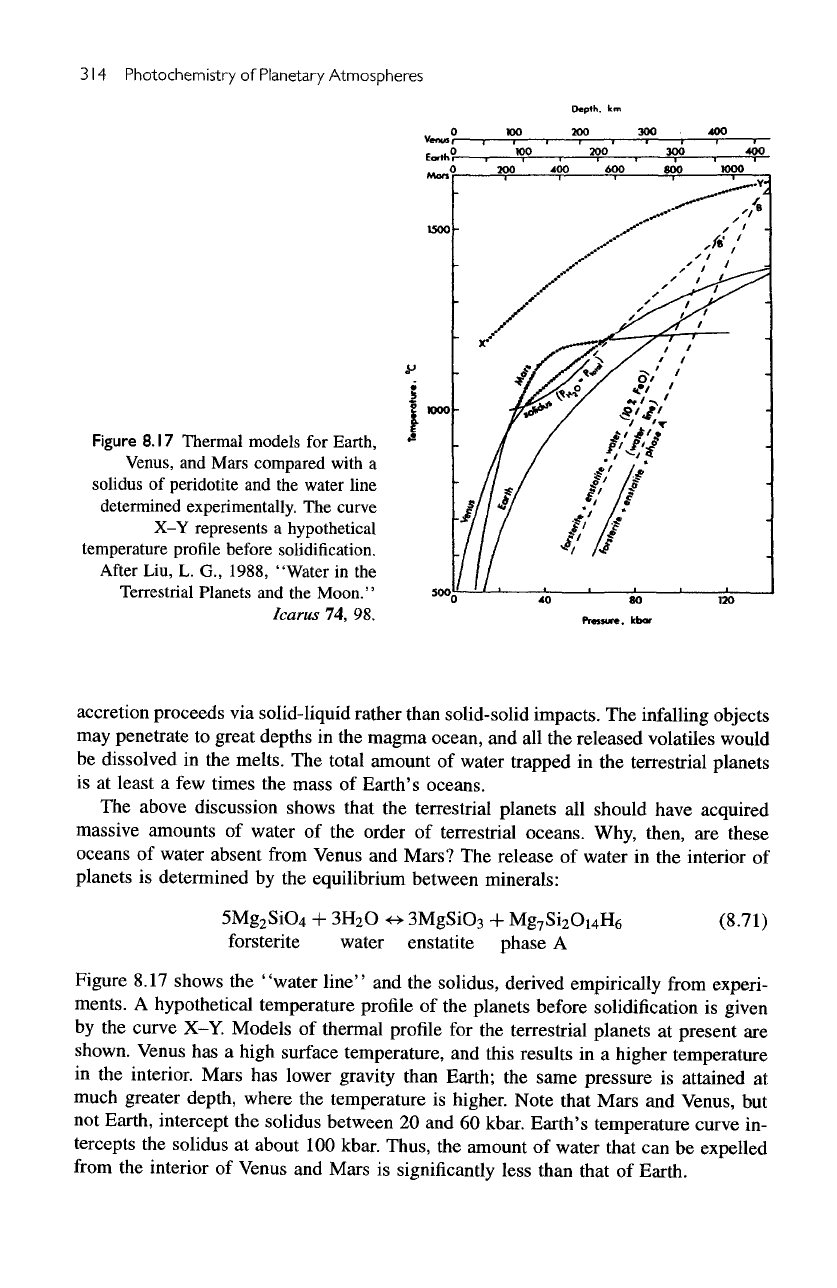Yung Y.L., DeMore W.B. Photochemistry of Planetary Atmospheres
Подождите немного. Документ загружается.


306
Photochemistry
of
Planetary Atmospheres
Figure
8.13
(a)
Concentrations
of
major
oxygen
species
(O,
O2,
03) in the
model,
(b)
Reaction
rates
of
major
reactions
forming
the
O—O
bond.
Based
on
Model
C in
Yung,
Y. L., and
DeMore,
W.
B.,
1982,
"Photochemistry
of the
Stratosphere
of
Venus:
Implications
for
Atmospheric
Evolution."
Icarus
51,
199.
The
reaction
S +
O
2
-*•
SO + O is the
rate-limiting
step
for
chemical
schemes
(Ilia)
and
(Illb).
Although
the
search
for
C>2
on
Venus
has
been
unsuccessful,
the
atmosphere
is
known
to be an
intense source
of
infrared
radiation arising
from
the
radiative decay
of the
excited state,
O
2
('A),
at
1.27
/urn.
The
observed
intensity
of 1 MR (1
mega-
Rayleigh
=
IO
12
photons
cm~
2
s~')
is
surprising because
it is of the
same order
of
magnitude
as the
total photolysis rate
of
CC>2.
The
excited oxygen
is
produced
in the
following
reactions:

Venus
307
Figure
8.13
(c)
Reaction
rates
of
major
reactions
breaking
the
O—O
bond. Based
on
Model
C in
Yung,
Y. L., and
DeMore,
W.
B.,
1982,
"Photochemistry
of the
Stratosphere
of
Venus:
Implications
for
Atmospheric Evolution." Icarus
51,
199.
The
excited
state
of
oxygen
is
lost
by
radiative
decay
or
quenching:
Quenching
of
O
2
('A)
by
CO
2
is
inefficient.
As a
result,
a
large
fraction
of the
energy
in
O
2
('A)
is
radiated away
by
(8.63).
The
emission rates deduced from
the
model
are
given
in
table 8.7.
Due to the low
quantum yields
of
reactions
(8.59)-(8.62)
for
producing
O
2
('A),
the
model cannot account
for the
observed emissions.
We
should
point
out
that
the
only
process
known
to
have
the
highest quantum yield
for
the
formation
of
C^'A)
in
laboratory studies
is
recombination
of
oxygen atoms
on
the
surface
of
pyrex
glass.
In the
mesosphere
of
Venus this
may
correspond
to the
recombination
of O
atoms
on the
surface
of
meteoritic dust. However, there
is no
independent
evidence
to
support
this
speculation.
The
major predictions
of the
model,
including
the
abundances
of the
major species
and
production rates,
are
summarized
in
table 8.8.

Table
8.7
Reactions capable
of
producing
O2('A)
emissions
in the
atmosphere
of
Venus
and
estimated
column
emission
ratio
Reaction
Emission
rate
(MR)
O
3
+ hv
o + o
O
+
HO;
Cl
+
O
}
C1O
+ O
Cl
+
CIOO
0.18
0.72
0.06
0.37
0.72
0.2
1
mega-Rayleigh
(MR)
=
10
12
photons
cm
2
s
'.All
estimates
are
taken
from
Yung,
Y.
U,
and
DeMore,
D. M.,
1982, Icarus
51,
199,
except
for
the
last
reaction proposed
by
Leu,
M.
T,
and
Yung,
Y.
L.,
1987,
Geophvs.
Res.
Lett.
14,
949.
Table
8.8
Concentrations
of
major
species
and
production
rates
predicted
by the
model
Physical
quantity
Model
/co
(62 km)
/co
(100
km)
fo
2
(62 km)
CO
column
abundance
O
2
column
abundance
Ratio
of CO to O2
column
abundances
Scale
height
of
SO
2
(70 km)
/so,
(70 km)
R1:CO
2
+ hv
R25:CO
+ OH
R101:CICO
+
O
2
R102:C1CO
+ O
0SOi
=
-<t>CO
R27~:OH
+
HCI
0H,
<fc>
O
2
('
A)
dayglow
O
2
('
A)
nightglow
4.8
x
10"
5
2.5
x
10"
3
1.5 x
10~
7
2.8
x
10
20
1.8
x
10
19
16
2.5
3.2
x
10"
8
7.6 x
10
12
4.9 x
10
12
5.0 x
10
12
1.2
x
10
12
1.4
x
10
12
3.0 x
10
9
0
-3.0
x
10
9
0.9 x
10
12
0.76
x
10
12
From
Yung,
Y.
L.,
and
DeMore,
W.
B.
(1982).
The
column abundances
and
column production rates
are
integrals from
58 to
1
10
km in
units
of
cm"
2
and
cm"
2
sec"
'
,
respectively,
/co
has
been
fixed at 58 km to
equal
4.5 x
10"
5
.
The
column abundance
of
CO
2
is 5 x
10
M
cm-
2
308

Figure
8.14
Schematic diagram
illustrating
the
coupled cycles
of
reduced
and
oxidized species
of
sulfur
in the
atmosphere
of
Venus. Transient species
are
enclosed
in
circles,
and
sta-
ble
species
in
rectangles.
The
dashed line represents
the
cloud
base.
After
Prinn,
R. G.,
1985, "The Photochemistry
of the
Atmosphere
of
Venus,"
in
Levine
(1985;
cited
in
section 8.1),
p.
281.
(a)
Figure
8.15
(a)
Abundances
of
H
2
O,
CO,
COS,
SO
3
,
and
H
2
SO
4
in the
lower
at-
mosphere
of
Venus
for a dry
model (solid lines)
and a wet
model (dashed lines).
After
Krasnopolsky,
V.
A.,
and
Pollack,
J.
B.,
1994,
"H2O-H
2
SO
4
System
in
Venus'
Clouds
and
OCS,
CO and
H
2
SO
4
Profiles
in
Venus'
Troposphere."
Icarus
109,
58.
309

310
Photochemistry
of
Planetary
Atmospheres
(b)
Figure
8.15
(b)
Reaction rates
of
major reactions involved
in the
transformation
of
species
shown
in
(a).
The
solid
and
dashed lines refer
to the dry and wet
models
in
(a). After
Krasnopolsky,
V.
A.,
and
Pollack,
J.
B.,
1994,
"H2O-H
2
SO
4
System
in
Venus'
Clouds
and
OCS,
CO and
H2SO4 Profiles
in
Venus'
Troposphere."
Icarus
109,
58.
8.3.3
Lower
Atmosphere
Our
knowledge
of
reduced
sulfur
in the
model
is
much
less
secure. Figure 8.14
illustrates
the
coupled cycles
of
reduced
and
oxidized
species
of
sulfur
in the
atmo-
sphere
of
Venus.
The
dashed line represents
the
cloud base. Above this line photo-
chemistry
dominates; below this
line
thermodynamic equilibrium chemistry
becomes
important,
especially
at the
surface.
A
model
of the
lower atmosphere
of
Venus
is
shown
in figure
8.15a.
Due to the
uncertainty
in our
knowledge
of
F^O
in the
atmosphere,
two
models have been used:
a
wet
model (dashed lines)
and a dry
model (solid lines).
The
mixing ratio
of COS
falls
with
altitude
since
the
source
is at the
surface
and the
sink
is
near
the
upper boundary
of
the
model.
The
species H2SO4,
SOs,
and CO are
produced above
the
cloud tops
and
are
destroyed
by
equilibrium
chemistry
in the
lower atmosphere. This accounts
for
their
decrease
as we
approach
the
surface.
The
rates
of the
major reactions destroying
CO and COS in the
model
are
given
in figure
8.15b.
We
must emphasize
the
tentative
nature
of
this model because most
of the
rate
coefficients
for the key
reactions
are
either
uncertain
or
unknown.

Venus
31
I
8.4
Evolution
The
definitive
evidence that
the
atmosphere
of
Venus
has
evolved extensively came
from
the
observed value
of the
D/H
ratio,
which
is
about
100
times
the
terrestrial
value
(see table 8.3). This implies
that
Venus must have lost
at
least
the
equivalent
of 100
times more water than
its
present reservoir.
The
loss
of
hydrogen from Venus
is
determined
by the
efficiency
of the
escape
processes,
the
rate
at
which hydrogen
is
transferred from
the
lower atmosphere
to the
upper atmosphere where
the
escape
processes
operate.
In
this section
we
discuss
the
mechanics
of
hydrogen
escape
in
some detail.
An
important process that
is
unique
to
Venus
is
chemical drying
of the
middle
at-
mosphere
by the
H2SO4
aerosols,
which
are
extremely hygroscopic. This
is
analogous
to the
cold trap that
operates
at the
tropical tropopause
of the
terrestrial atmosphere
to
freeze-dry
the air
that enters
the
stratosphere.
We
should note that
the
chemical
drying
mechanism
is
effective
only when
the
condition
is
satisfied.
It may not
have been
as
effective
in the
past when water
was
more abundant
than
H2SO.4,
violating
(8.65).
The
evolution
of
water
on
Venus
is
thus closely tied
to
the
chemistry
of
sulfur
in the
atmosphere. Relatively
little
work
has
been done
on
this
subject.
8.4.1
Escape
of
Gases
The
gravity
of
Venus
is
sufficiently
strong that even
H
atoms cannot
escape
thermally
from
Venus.
The
principal mechanisms
for the
escape
of
hydrogen
and
other light
gases
are
nonthermal,
including
charge
exchange,
collisional
ejection,
and
solar
wind
impact.
The
most important
process
for the
escape
of
hydrogen
is via the
resonant charge
exchange reactions that take place
in the
exosphere:
In
this
process
the
thermal (cold)
H
atom charge exchanges
with
O
+
to
form
H
+
.
H
+
is
accelerated
to the
high temperature
in the
plasma
by
electromagnetic forces.
The
hot
H
+
can
transfer charge with
O to
produce
a hot H
atom. This atom
may now
escape
if its
velocity vector
is
pointed upward.
H
atoms
in the
exosphere
may
also
be
accelerated
by
collision with
hot
atoms that
are
produced
in the
dissociative reaction
This reaction
is
exothermic
by
6.98
eV,
producing nonthermal
O
atoms
with
v
0
=
6.49
km
s~'.
If one of the
atoms
is in the
excited
'D
state,
v
0
becomes somewhat less,
5.5 km
s~'.
Unlike
the
case
for
Mars,
O*
produced
in
reaction (8.68)
is not
energetic
enough
to
escape
from Venus. However,
the
elastic collision

3
12
Photochem
istry
of
Planetary
Atmospheres
Figure
8.16
Evolution
of D/H
ratio
in the
atmosphere
of
Venus.
The
observational
constraints
are
shown
by the
gray bar.
After
Gurwell,
M.
A.,
1995, "Evolution
of
Deuterium
on
Venus."
Nature 378,
22.
is
efficient
at
transferring momentum
to the H
atom,
and H* can
attain velocities
in
excess
of the
escape
velocity
of
10.2
km
s~'.
The
collision
is
also capable
of
ejecting
heavier
atoms:
where
X
=
D,
3
He
or
4
He
if we
take into account
the
thermal energy
of the ion in
(8.68).
The
efficiency
is of
course less than that
for
(8.69).
Venus
does
not
have
a
magnetic
field. As a
result,
the
solar wind interacts directly
with
the
exosphere
of the
planet.
The
solar wind
is
composed primarily
of
protons.
Direct sputtering
of the
atmosphere
by the
solar
wind
is
important only
for the
light
gases.
Momentum transfer from protons
to
heavy atoms such
as O is
inefficient.
However, there
is an
indirect solar wind-induced process that
may
play
a
fundamental
role
in the
evolution
of
Venus.
The
solar wind carries
its own
magnetic
field. In flowing
past Venus
the
magnetic
field
generates
an
electric
field
that
can
accelerate
the
O
+
ions
to keV
energies. Reimpacting
the
atmosphere,
the
energetic
O
+
ions
can now
efficiently
sputter material (including heavy atoms)
off the
exosphere
of
Venus.
The
rates
of
escape
of
hydrogen
due to
charge
exchange,
collisional ejection,
and
solar wind impact
are 1 x
10
7
,
3 x
10
6
,
and 1 x
10
5
atoms
cm"
2
s"
1
,
respectively,
for
the
present epoch. This rate
of
escape
implies that
the
e-folding
time
for the
loss
of
H
2
O
on
Venus
is
only
500
Myr,
a
geologically
insignificant
length
of
time. This
leads
to the
suggestion that water
on
Venus
may be
resupplied
by
cometary
impacts.
The
rate
of
loss
of
oxygen might have been higher
in the
past
due to a
more active
sun
that emitted more
UV and
corpuscular radiation.
The
only
constraint
we
have
on
the
total
amount
of
hydrogen that
has
escaped
is the
D/H
ratio, which
is
discussed
in
section
8.4.2.
8.4.2
Isotopic
Signature
An
analysis
of
D/H
fractionation
due to the
difference
in the
escape
efficiencies
of
H
and D is
given
in
section
7.4.2.
The
crucial
fractionation
factor
/ is
close
to 0
for
charge exchange
but is as
high
as
0.47
for
collisional ejection.
By
weighting
the
various
escape
processes,
the
mean value
for / has
been estimated
to be
0.13.
The
evolution
of the
D/H
ratio
in the
atmosphere
of
Venus
is
summarized
in figure
8.16.
The
time axis
is
given
in
units
of the
escape
lifetime
of H
(85-800
Myr). There
are
essentially
two
opposing models.
One is the
dissipation
of a
massive primordial
ocean, leading
to
very large
fractionation
of D. The
other
is an
equilibrium
model

Venus
313
Table
8.9
Estimated total
H
2
O
buried inside
the
growing solid Earth, Venus,
and
Mars
Earth
Venus
Mars
Radius
at
which impact
deyhdration
starts,
R
\
(km)
Mass
at
which deyhdration
starts
(10
22
kg)
Amount
of
H
2
O
buried inside
/?,
(10
20
kg)
Radius
at
which
complete
deyhdration
starts,
/?2(km)
Mass
between
RI
and
RI
(10
23
kg)
Amount
of
H
2
O
buried between
R
t
and
R
2
(10
21
kg)
Total
buried
H
2
(10
21
kg)
1150
3.5
1.2
3190
7.1
1.2
1.3
1210
3.9
1.3
3330
7.7
1.3
1.4
1370
4.2
1.4
>3390
5.9
1.3
1.4
Model
by Liu
(1988) based
on the
impact
dehydration model proposed
by
Lange
and
Ahrens (1984),
assuming
that
the
fyO
content
of
Ihe
infalling
materials
is
0.33
wt%.
with
the
water
on
Venus being supplied
by
comets.
This model
leads
to
predicted
D/H
ratio that
is too
low.
A
time-dependent synthesis model
is
shown
in figure
8.16.
The
observational constraints
are
marked
by the
gray bar.
The
nominal model
predicted
an
initial
global
ocean
of 85
m
on
Venus.
The
minimal
model (within
limits
of the
gray
bar)
had a 5.4 m
primordial
ocean.
8.5
Mystery
of the
Missing
Water
Earth
is
unique
in the
solar
system
in
having massive
oceans
of
water.
The
total
amount
of
water
in the
oceans
is 1.5 x
10
21
kg. The
entire near-surface
geochemical
reservoirs
(oceans
+
crust)
contain
about
2 x
10
21
kg of
water.
Water
is
deficient
on
Venus
by a
factor
of
10
4
to
10
5
relative
to
Earth.
Escape
can
account
for a
factor
of
at
least 100.
The
rest
of the
difference must
be
accounted
for by a
speculative theory
of
hydrodynamic
escape
or a
theory
of
planetary evolution.
We
briefly
describe
an
explanation
based
on the
latter idea.
It
is now
generally accepted that
the
origin
of
water
in the
planets
is
dehydration
of
hydrous minerals during formation.
The
bulk
of
infalling
material
has
composition
similar
to
that
of
CI
chondrites that contain
up to 3
wt%
H
2
O.
Once
the
accreting
planetary body
exceeds
a
critical size, impact velocities
become
sufficiently
high that
devolatization
can
start.
The
critical radii,
R\, for
Earth, Venus,
and
Mars
are
about
20%, 20%,
and 40% of
their present radii, respectively (see summary
of
these values
in
table 8.9). Complete devolatization (total
loss
of
F^O
to
space)
can
occur when
the
planets grow
to
another critical radius,
#2-
The
values
for
/?2
given
in
table
8.9
are
roughly
50% of the
present radii
for the
Earth
and
Venus;
Mars
never
reached
/?2.
Estimates
of
water buried inside
the
growing terrestrial planets
are
summarized
in
table
8.9
assuming that
the
infalling
body contains 0.33
wt%
water. Thus,
the
amount
of
sequestered water
is of the
order
of
that
in the
terrestrial
oceans.
This
is
a
conservative estimate because
we
have assumed that
the
impacts
are
between solid
bodies.
When
the
growing planetary body
reaches
a
certain
fraction
of its final
size,
it
may
be
covered
by a
magma ocean.
Once
this magma ocean
is
formed, subsequent

314
Photochemistry
of
Planetary Atmospheres
Figure
8.17
Thermal models
for
Earth,
Venus,
and
Mars compared with
a
solidus
of
peridotite
and the
water line
determined experimentally.
The
curve
X-Y
represents
a
hypothetical
temperature
profile
before
solidification.
After
Liu,
L. G.,
1988,
"Water
in the
Terrestrial Planets
and the
Moon."
Icarus
74, 98.
accretion
proceeds
via
solid-liquid
rather than solid-solid impacts.
The
infalling objects
may
penetrate
to
great depths
in the
magma ocean,
and all the
released volatiles would
be
dissolved
in the
melts.
The
total amount
of
water trapped
in the
terrestrial planets
is
at
least
a few
times
the
mass
of
Earth's oceans.
The
above discussion shows that
the
terrestrial planets
all
should have acquired
massive amounts
of
water
of the
order
of
terrestrial oceans.
Why,
then,
are
these
oceans
of
water absent
from
Venus
and
Mars?
The
release
of
water
in the
interior
of
planets
is
determined
by the
equilibrium between minerals:
Figure
8.17
shows
the
"water
line"
and the
solidus,
derived
empirically
from
experi-
ments.
A
hypothetical temperature profile
of the
planets before solidification
is
given
by
the
curve
X-Y.
Models
of
thermal
profile
for the
terrestrial planets
at
present
are
shown.
Venus
has a
high surface temperature,
and
this results
in a
higher temperature
in
the
interior. Mars
has
lower gravity than Earth;
the
same
pressure
is
attained
at
much greater depth, where
the
temperature
is
higher. Note that Mars
and
Venus,
but
not
Earth, intercept
the
solidus between
20 and 60
kbar.
Earth's temperature curve
in-
tercepts
the
solidus
at
about
100
kbar. Thus,
the
amount
of
water that
can be
expelled
from
the
interior
of
Venus
and
Mars
is
significantly less than that
of
Earth.

Venus
315
8.6
Unsolved
Problems
We
list
a
number
of
outstanding unresolved problems related
to the
atmosphere
of
Venus
and its
comparison
with
those
of
Mars
and
Earth.
1.
Why is
Venus
deficient
in
water?
If the
bulk
of
water
is
inside
the
planet,
is
there
any
observational evidence?
2. Is
heterogeneous chemistry
of
chlorine compounds
on the
surface
of
sulfuric
acid
aerosols important?
3. Is
lightning
a
source
of
NO*
in the
lower atmosphere
of
Venus?
4.
Does
NO*
chemistry play
a
role
in the
photochemistry
in the
mesostratosphere?
5.
What
is the
nature
of the
unidentified
UV
absorber?
6.
What
is the
detailed mechanism
for the
production
of
reduced
sulfur
species
on
Venus?
7.
Is
SOa
geochemically
stable
on
Venus? Must
it be
resupplied
by
volcanism?
8.
What
is the
evolutionary history
of
water
on
Venus?
9. Is
Venus volcanically active
in the
current epoch?
10.
How
does
the
atmosphere interact with
the
interior
of the
planet?
Are
there tectonic
processes
on
Venus?
11.
Why are the
noble
gas
contents greatly enhanced
on
Venus relative
to the
other
terrestrial planets?
